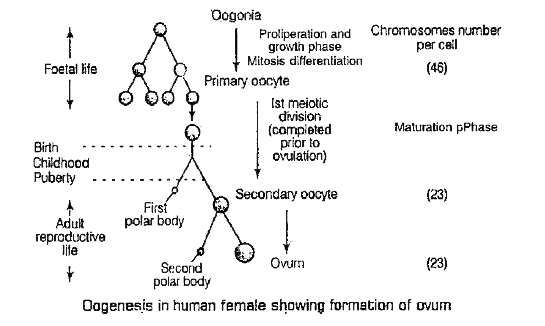What is Oogenesis ? Briefly describe the process of Oogenesis in human female.Solution in Punjabi
Video Solution
Text Solution
Oogenesis. The process of formation of mature haploid ova from the oogonia (gamete mother cells) in the ovaries is called as oogenesis.
It consists of three phase
(i) Proliferative or Multiplication phase (ii) Growth phase (iii) Maturation phase
(i) Mutliplication phase. The germinal epithetial cells of the ovary divide by mitosis during embryonal stages, forming millions of gamete mother cells (oogenesis) in the foetal ovary. No more oogenia are formed after birth. Oogenia start mitotic divisions and enter prophase-I and get temporarily arrested at this stage to form primary oocytes.
(ii) Growth phase. This phase of the primary oocyte is very long. It may extend over many years. The oogonium grows into a large primary oocytes. Each primary oocyte then gets surrounded by a layer of granulosa cells to form primary follicle. A large number of these follicles degenerate during the period from birth to puberty. So at puberty only 60,000-80,000 primary follicles are left in each ovary. The fluid filled cavity of the follicle is called antrum.

(iii) Maturation phase. Like a primary spermatocyte, each primary oocyte undergoes two maturation divisions, first meiotic and the second meiotic. The results of maturation divisions in oogenesis are, however, very different from those in spermatogenesis. In the first, meiotic division, the primary oocyte divides into two very unequal haploid daughter cells a large secondary oocyte and a very small first polar body or polocyte. In the second maturation division, the first polar body may divide to form two second polar bodies. The secondary oocyte again divides into unequal daughter cells, a large ootid and a very small second polar body. The ootid grows into a functional haploid oyum. Thus from one oogonium, one ovum and three polar bodies are formed. The ovum, is the actual female gamete. The polar bodies take no part in reproduction and, hence, soon degenerate. In human beings, ovum is released from the ovary in the secondary oocyte stage. The maturation of secondary oocyte is completed in the mother.s oviduct (Fallopian tube) usually after the sperm has entered the secondary oocyte for fertilization. In humans (and most vertebrates), the first polar body does not undergo meiosis II, Whereas the secondary oocyte proceeds as far as the metaphase stage of meiosis II. However, it then stops advancing any further, it awaits the arrival of sperm for completion of meiosis tt Entry of the sperm restarts the cell cycle breaking down MPF (M-phase promoting factor) and turning on Anaphase promoting complex (APC). It converts the secondary oocyte into fertilised egg (zygote) and a second polar body is formed.
|
Similar Questions
What is Oogenesis ? Briefly describe the process of Oogenesis in human female.
View SolutionWhat is oogenesis ? When does oogenesis begins in female ? Describe briefly the process of oogensis with help of suitable diagram.
View SolutionDescribe the process of Oogenesis.
View SolutionDescribe the process of oogenesis.
View SolutionWhat is Placenta? Explain briefly oogenesis process in human beings.
View SolutionBriefly describe the process Oogenesis.
View SolutionWhat is oogenesis? State briefly the process of oogenesis. Write the function of inhibin.
View SolutionDescribe oogenesis in human female.
View Solution
